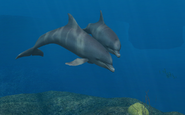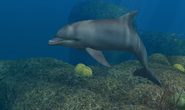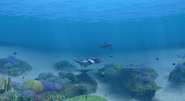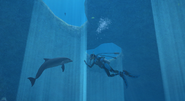← Manta RayEndless Ocean Creatures
Endless Ocean 2 CreaturesCommon Dolphin →
Pacific White-Sided Dolphin →
- See also: Bottlenose Dolphin Partner
The bottlenose dolphin (Tursiops truncatus) is a species of dolphin found in both Endless Ocean and Endless Ocean 2.
Due to its distinct and simple appearance, as well as its playful nature, it is one of the most recognizable species of dolphin in the world. Frequent appearances in pop culture and documentary pieces contribute to its fame.
In-Game
Marine Encyclopedia
Endless Ocean
Description
"These mammals have spindle-shaped bodies with short, wide beaks. They are gray on the back and light gray on the belly and can be seen in the central hall of the Mo'ia Atoll ruins year-round.
They usually form groups of several dozen animals but have been known to swim in groups of hundreds when offshore. they often ride the crests of waves made by ships or large whales and are commonly seen swimming alongside ships.
Many bottlenose reside near inlets and shorelines and seem to enjoy interacting with humans. They are referred to as the "friendly dolphin" and are generally loved by all the people who live in such areas. Recently, scientists have begun research into animal therapy that investigates the healing properties of swimming with and being near dolphins."
Partner Description
"One of your in-game partners. The first dolphin you meet in the waters of Manaurai. It is a little unusual as bottlenose dolphins are rarely seen in these waters. There must be a colony of them hidden somewhere in the vicinity.
Playful and full of energy. Constantly makes various speaking sounds underwater and clearly has a talkative personality. This specimen is around ten years old, but others in the species have been known to live more than thirty years.
Always held in high regard by tourists, yet in ancient times for the inhabitants of the neighboring islands of the Paoul Republic, the bottlenose dolphin was once seen as an object of faith and up until around a hundred years ago was not to be approached. But dolphins are curious and tend to approach humans. When this happened it was said that they brought happiness to devout believers."
Endless Ocean 2
Description
"This is the best-known species of dolphin and the one most often seen in aquariums. In the wild, it often forms groups, or pods, of around 15. These pods can even contain several hundred dolphins. It has a habit of playing in the wake of ships or large whales and is often seen swimming alongside boats."
[Getting Close to Humans]
"Some bottlenose dolphins settle in coves or coastlines, where they seem to enjoy playing with humans and become famous among local inhabitants.
Dolphins are also used in animal-assisted therapy, where a person interacts with an an animal as part of their therapy. This special form of therapy is continually being researched and is gaining favorable attention."
Location
Endless Ocean
In Endless Ocean, the first bottlenose dolphin the player encounters is seen at the Lagoon, and is spotted numerous times early on in the game. It serves as the player's introduction to the idea of dolphin partners, and is likely the first dolphin partner the player will have. A pod also found in the Underwater Ruins of Mo'ia Atoll, occupying the Central Hall; this makes them the only befriendable dolphin species in the game that can be found in multiple areas.
Endless Ocean 2
Three are found swimming around Cross Rift in Ciceros Strait. An albino bottlenose dolphin can be found swimming in the cave underneath, but only during the "White Dolphin of Ciceros" quest, where it's under attack from an aggressive tiger shark.
A couple of specimens can also be found on the Echoing Terrace during the player's first visit to the Cavern of the Gods, though they are not permanent residents.
Behavior
Bottlenose dolphins swim around quickly in loose pods. They respond positively to the Sea Whistle, like most other cetaceans in the games. In Endless Ocean 2, using the whistle near them will unlock their trivia.
Gallery
Notes
- This is one of Jean-Eric's favorite creatures.
- A bottlenose dolphin acts as the loading icon in Endless Ocean.
Real-Life Information
- The in-game descriptions for this animal describe them as usually forming smaller pods, but with the tendency to sometimes congregate in the hundreds; this is accurate[1][2][3]. However, the first game describes the typical pod size as "a few dozen"; however, they are usually less than twenty, averaging about twelve to fifteen[1][4][5].
- One of the known predators of the bottlenose dolphin is the tiger shark[6]. This means that the albino bottlenose dolphin being targeted by a tiger shark in Ciceros Strait is somewhat realistic. Predators usually pursue weaker and younger dolphins rather than larger ones, so a dolphin with poor eyesight like the albino bottlenose would make for a good target.
- Both in-game descriptions make note of dolphins taking part in animal-assisted therapy that is undergoing current research, and this is true; reports of the experience describe it as highly positive[10]. However, there are concerns that the idea of "dolphin-assisted therapy", or DAT, may further encourage the capture of wild dolphins, in addition to being a potential way to extort desperate people who are willing to try any treatment that might work[11]; there is not much evidence suggesting that it actually has any lasting positive psychological effects[12][13].
- Though bottlenose dolphins are captured from the wild on occasion for reasons such as these, the International Union for the Conservation of Nature states that they are not currently at risk of going extinct[14].
- Other common names for Tursiops truncatus include common bottlenose dolphin and Atlantic bottlenose dolphin[7][15][16]; this is to differentiate it from the entire Tursiops genus, which is sometimes referred to with name "bottlenose dolphin"[17][18].
- The genus Tursiops has three separate species, including Tursiops truncatus[18][19]. T. aduncus, the Indo-Pacific or Indian Ocean bottlenose dolphin, was described in 1832, and T. australis, the Burrunan dolphin, was described more recently in 2011[20][21][22].
- Neither of these other species appear in either of the Endless Ocean games.
- There are three subspecies of common bottlenose dolphin. The first, Tursiops truncatus truncatus, is usually simply called the common bottlenose dolphin; the second, T. truncatus ponticus, is called the Black Sea bottlenose dolphin; the third, T. truncatus gephyreus, is called Lahille's bottlenose dolphin[23][24].
- There are also two ecotypes of bottlenose dolphin - a coastal variant, and an offshore or oceanic variant[1][8][25][26]. An ecotype is a population of animals in a specific species that have adapted to specific environmental conditions in a different way than other populations of their species[27].
- The genus Tursiops has three separate species, including Tursiops truncatus[18][19]. T. aduncus, the Indo-Pacific or Indian Ocean bottlenose dolphin, was described in 1832, and T. australis, the Burrunan dolphin, was described more recently in 2011[20][21][22].
- Bottlenose dolphins are known for their remarkable intelligence. This has been tested in many ways, such as categorization of objects, use of artificial language, recognition of self, and mimicry of given signals[28][29][30]. They are also extremely socially intelligent, and they have been known to utilize tools, such as their use of sponges to protect their snouts from potentially harmful surfaces[31][32].
- Common bottlenose dolphins have an exceptionally complex communication system, which is particularly noticeable by the fact that each dolphin uses a distinctive and unique whistle to communicate their identity and location to other dolphins[1][4]. They each even have their own "name", a specific pattern of whistles used by the dolphins around them to get their attention[23][35].
- Famously, they also use echolocation to hunt. They emit clicking noises from their blowholes, and these sounds bounce off of the environment in different ways, which lets the dolphin know more about the environment around them[34][36][37].
- Toothed whales like the bottlenose dolphin do not make most of their vocalizations with their vocal cords, or larynx, like most mammals do; instead, they usually make sounds with tissue in their nasal cavities[38][39].
- Bottlenose dolphins are very good swimmers; they are able to reach speeds of over 20 miles per hour (32 kph)[40][41]. This agility contributes to their jumping ability - they can jump as high as 15 to 20 feet (4.5 to 6 meters) out of the water[42]. However, they are not the highest-jumping dolphins; a trained Pacific white-sided dolphin can jump up to 30 feet (10 meters)[43].
Bottlenose Dolphin
• Pacific White-Sided Dolphin
• Short-Beaked Common Dolphin
Commerson's Dolphin
• Orca
• Risso's Dolphin
• Beluga
• False Killer Whale
• Narwhal
Spectacled Porpoise
• Amazon River Dolphin
• Southern Bottlenose Whale
• Humpback Whale
North Atlantic Right Whale
• Pygmy Sperm Whale
• Antarctic Minke Whale
• Gray Whale
Sperm Whale
• Blue Whale
References
- ↑ 1.0 1.1 1.2 1.3 Oceana.org
- ↑ Food and Agriculture Organization of the United Nations Fisheries and Aquaculture Department
- ↑ ASCOBANS
- ↑ 4.0 4.1 MarineBio
- ↑ North Atlantic Marine Mammal Commission
- ↑ 6.0 6.1 Animal Diversity Web (Tursiops truncatus)
- ↑ 7.0 7.1 NOAA Fisheries Department
- ↑ 8.0 8.1 Australian Government Department of Agriculture, Water, and the Environment
- ↑ Marine Mammal Center
- ↑ Dolphins World (Dolphin Assisted Therapy)
- ↑ Dolphin Project
- ↑ Psychology Today
- ↑ Aeon Magazine
- ↑ IUCN Red List
- ↑ Texas State Aquarium
- ↑ National Aquarium
- ↑ Animal Diversity Web (Genus Tursiops)
- ↑ 18.0 18.1 ITIS Report (Genus Tursiops)
- ↑ World Register of Marine Species (Genus Tursiops)
- ↑ WRoMS (T. australis)
- ↑ WRoMS (T. aduncus)
- ↑ "A New Dolphin Species, the Burrunan Dolphin Tursiops australis sp. nov., Endemic to Southern Australian Coastal Waters"; Kate Charlton-Robb, Lisa-ann Gershwin, Ross Thompson, Jeremy Austin, Kylie Owen, and Stephen McKechnie
- ↑ 23.0 23.1 23.2 Whale and Dolphin Conservation
- ↑ ITIS Report (T. truncatus)
- ↑ 25.0 25.1 25.2 25.3 American Cetacean Society
- ↑ FAO Fisheries
- ↑ Northern Arizona University
- ↑ New York Times
- ↑ Proceedings of the National Academy of Sciences of the United States of America
- ↑ "It's Time for a Conversation", National Geographic
- ↑ Dolphins-world
- ↑ "How intelligent are whales and dolphins?"; Whale and Dolphin Conservation
- ↑ Naval Information Warfare Center
- ↑ 34.0 34.1 National Geographic
- ↑ "Bottlenose dolphins can use learned vocal labels to address each other"; Stephanie L. King and Vincent M. Janik
- ↑ Dolphins World (Dolphin Echolocation)
- ↑ NOAA Fisheries (Echolocation)
- ↑ Discovery of Sound in the Sea
- ↑ LiveScience
- ↑ Biology Dictionary
- ↑ PBS Ocean Realm
- ↑ Carolina Marine Group
- ↑ Scienceing: "How High can Dolphins Jump?"; Shelley Moore
- ↑ Whale Trail














